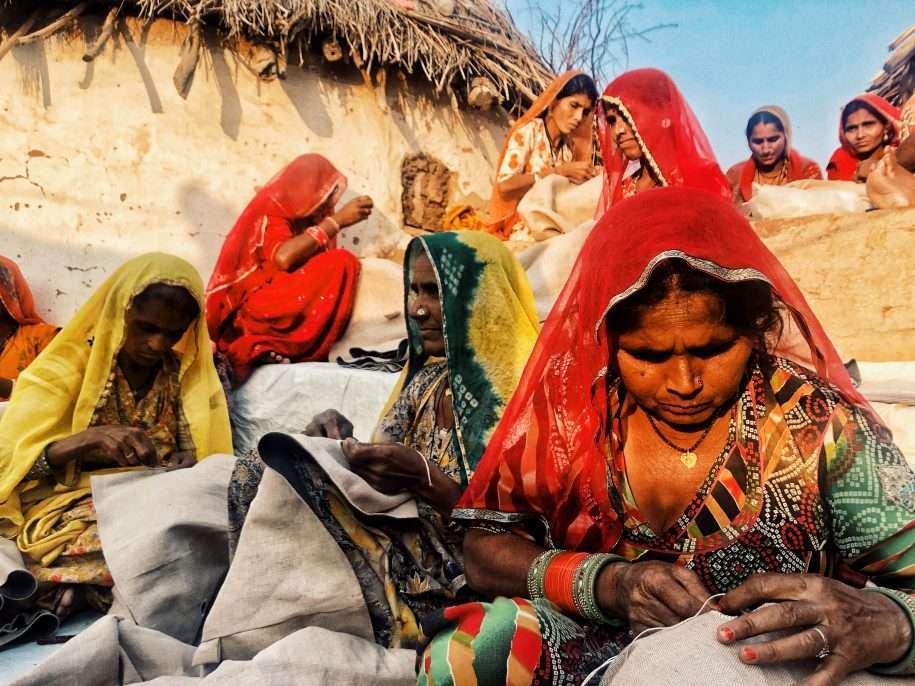About 80 kms from the arid city of Bikaner in Rajasthan, lies a small town Pugal, famous for its intricate hand embroidery and handwoven textiles. In the heart of the town stands a community center, where women from the neighbourhood come together to work on handicrafts and textiles.
Rangsutra, a social enterprise established in 2005, is enabling these artisans to step out of their homes for the first time and be a part of the workforce. Rangsutra is working with the artisans to ensure that their craft can go places, and contribute to their socio-economic prosperity by providing regular work and fair wages, thereby creating an opportunity for them to act as agents of change within the community.
Employees turn Entrepreneurs
In the rural areas of Rajasthan, unlike other employers who pay artisans on a daily wage basis, Rangsutra has transformed the lives of 2000+ women, by recognizing them as shareholders in their for-profit company. Rangsutra ensures regular opportunities for these women by collaborating with big market players like FabIndia and IKEA, and in turn builds their confidence and capacity to cater to a global clientele.
In a recent field visit to Bikaner, we had the opportunity to interact with some of the artisans. They reported having a fluctuating income of Rs. 1000 per month for menial, irregular jobs that they did prior to joining Rangsutra. Fast forward to today, and their average incomes have registered 600%-700% growth, with most of them now earning an average of Rs. 8000 per month with Rangsutra. Women’s participation in the workforce is largely influenced by societal dictation of their primary role as caretakers. A woman artisan’s typical day begins at the crack of dawn, cooking and spending time in childcare responsibilities from 5 am. Work at the center starts from 9 am and stretches to 5 or 6 pm, with a 30-minute lunch break in-between. The women then head back to their homes to continue with the usually undervalued domestic care responsibilities.
Vadri bai, a 55 year old shareholder, who has worked with Rangsutra for 13 years and with an overall craft experience of 35 years says, “We like that our income is now regular as we can spend major expenses on health, education, weddings (Rs. 1.5 lakhs), farming land.” She added that ‘mahila sangathan ki shakti’ – the power of women groups – and ‘loan and insurance products’ is also helpful.
Women reported that Rangsutra drastically improved their standard of living, leading to a strong sense of ownership and pride in their work. Adding to the success, women have also been able to contribute to meet regular home expenses and promote savings. “Coming to work has increased their mobility for work and many of them have first generation school children, increasing their likelihood for a good life. The nearest school until 10th standard school is in Delitadai, which is outside the village, so many females drop out due to restricted mobility. Now, with Rangsutra they are able to fight mobility barriers for their children, caste barriers and not promote child labour.” says Avesh, the operations manager. Rangsutra has had a great social impact with the community by giving the women the ability to leave their household for work in full day shifts, leading to their empowerment.
Over the years, India’s female work force has witnessed three key trends. Women undertake the majority of unpaid care responsibilities compared to men, resulting from gendered assumptions about suitable roles of women in society. Employed women usually work in the informal sector which is characterised by low and uncertain wages and risky working conditions, Women are also bound by time constraints as a result of domestic tasks. Rangsutra aims to change the landscape.
50-year old Havli, who has been working for 20 years out of which 5 years was with Rangsutra, said “Regular work is good as I am able to manage my household expenditure easily. Earlier, at home I used to be less motivated. Here at the Rangsutra center, I feel a sense of competition. I see a fellow artisan doing more work, which will give her more income, so I feel like working more and earning as much!” followed by giggles amongst all in agreement of the healthy competition and productive work environment. She added that she learnt the skill through family tradition which has been practiced since generations. She does not like to be free and feels hand work is better than machine work. Secondary sources of income include agriculture, which is seasonal in nature – major crops are mustard, wheat, chickpea. In addition, they have livestock such as cows and goats which give milk.

The women like Rangsutra since they are paid fair wages and the organisation is transparent with all of its women artisans. It was interesting to see how Rangsutra overcame cultural and societal hurdles. Around three years back, they made all participating women artisans operate out of common working centres to uphold the quality of their products. This also helped women artisans become independent, both financially as well as culturally. These women artisans have gained confidence as they are now supporting their families through their regular incomes. They are helping their children secure quality education, with most of them sending them for higher education outside their village area. Rangsutra is building their capacity to produce crafts and wares at scale as well as strengthening their social capital and networking opportunities, which are important contributors of empowerment.
Rekha, a 20-year old artisan, has been working at the center for two years. She learnt embroidery work from her mom. She now has her own bank account. She gives a certain amount to the family, shops for food and fruits from some of the money, and supports her family of six members . At times, her home sells goats for Rs. 2,500 to earn money or dairy of cows and goats in case there is excess quantity. Her family has agricultural land, but they prefer renting the 25 acre land to get monthly rent. On inquiring about her three substantial changes in her life post Rangsutra, she said, “Life has changed for good. I can now contribute to home expenditure, fund my siblings’ education. I am more respected and loved because I earn Rs. 9000 to Rs. 10,000 a month. And I also have access to an ATM, though I can’t use a phone due to cultural factors.” It is interesting to see young women earn more as they are free from house and agriculture related responsibilities and would be nice to know what role can ICT play in further transformation.
Digital solutions for the last-mile
While Rangsutra is doing fantastic work at the frontline, they do not possess any data on the socio-economic impact on the women artisans. They have also not yet digitized their ERP system, resulting in a lot of manual errors. With LEAD’s past experience in working for the last mile via digitization with Catalyst, we are collaborating with Rangsutra to identify and test potential solutions to digitize their workflow and supply chain. During the first phase, we will conduct a baseline with the primary goal of creating digital footprints for the artisans engaged with Rangsutra. Additionally, we will help Rangsutra implement a digital ERP solution across their entire supply chain. These data trails and ERP can then be eventually used to provide additional value added services to these artisans, something they lacked in the past.
We will continue to share our learnings with you through these blogs. Stay tuned!
About the Authors
Kanika Joshi is a Research Manager at LEAD at Krea University. A development practitioner with a multi-sectoral understanding of working with nonprofits across the global south, she is deeply passionate about youth empowerment, women in MSMEs, entrepreneurship and anything SDGs. She loves to leverage qualitative research for understanding grassroot realities.
Deepanshu Khandelwal is the Chief Executive Officer at Catalyst. A seasoned entrepreneur with a diversified entrepreneurial experience across media, health-tech and operations/supply chain, he also acts as a board advisor for multiple growth-stage technology ventures. He is passionate about technology & entrepreneurship, and the quintessential role of these two, in stimulating grassroots innovation.





